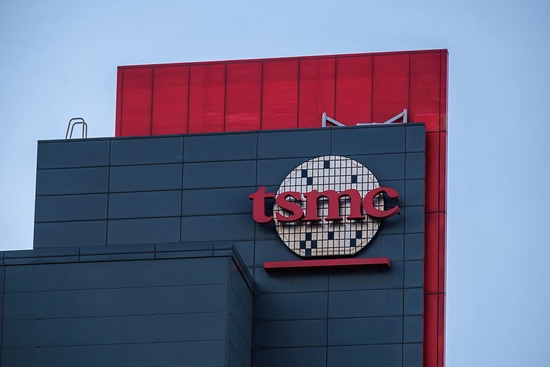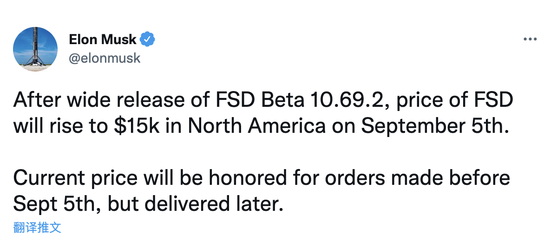your current location is:Home > TechnologyHomeTechnology
TSMC's quarterly revenue is still a record high, but revenue in September fell 4.5% month-on-month

The foundry giant TSMC disclosed that its revenue in September stood at the NT$200 billion mark, the second highest in a single month, ending a continuous record high.
On October 7, data released by TSMC showed that the consolidated revenue in September was 208.248 billion yuan (the following units are in New Taiwan dollars), a decrease of 4.5% from the previous month and a year-on-year increase of 36.4%, setting the second highest in a single month. In the third quarter, revenue was 613.143 billion yuan, the ninth consecutive quarterly record high. In the first three quarters of this year, TSMC's consolidated revenue was 1,638.36 billion yuan, a year-on-year increase of 42.6%.
However, due to the month-on-month decline in revenue in September, TSMC's share price was weak that day, closing at 438 yuan, down 13 yuan. TSMC ADR suffered a heavy setback in US stocks that day, closing down 6.19%.
Zhu Jing, deputy secretary-general of the Beijing Semiconductor Industry Association, said that the month-on-month decline in revenue in September was mainly due to weak market demand, but TSMC should be the best performing semiconductor factory.
TSMC will hold a legal meeting on October 13. The outside world will mainly focus on its operating outlook for this quarter and its views on the semiconductor market next year.
Recently, "bad news" has been reported frequently on the semiconductor demand side. AMD, one of TSMC's major customers, recently released an estimated third-quarter revenue of about $5.6 billion, which is not a small gap from the previous estimate of $6.71 billion, which means that the chip recession may be more serious than expected. many. At the same time, AMD expects gross profit to decline in the third quarter, showing that non-GAAP gross margins are expected to be around 50%, compared with an earlier estimate of close to 54%.
AMD's shares fell 4% in after-hours trading after the announcement, further dragging Nvidia and Intel down more than 2%.
AMD CEO Su Zifeng said in a statement that the overall PC demand was lower than expected due to significantly weaker PC (personal computer) market demand this quarter, coupled with the overall poor global economic conditions.
AMD said shipments of the company's processors fell significantly due to a weaker-than-expected PC market and an overstocked supply chain. PC segment revenue missed expectations, falling 53% sequentially and 40% year-over-year.
Previously, another major customer of TSMC, Nvidia, has missed expectations for two consecutive quarters. Nvidia’s second-quarter results showed that graphics cards for both gaming and cryptocurrency declined.
Nvidia explained that the failure of the game business was mainly due to the decline in sales of game product terminals, mainly PCs. Analysts believe that the huge changes in the virtual currency market are also an important reason for the weakness of NVIDIA's game business.
Taiwan Economic Daily said that TSMC previously estimated that the US dollar revenue in the third quarter was between US$19.8 billion and US$20.6 billion, with a quarterly increase of 11.2%. 588.06 billion yuan to about 611.82 billion yuan. The NTD depreciated to a price of around 31.6 yuan. After TSMC's single-quarter performance was factored into exchange rate factors, it was still roughly in line with outside expectations.
However, based on its own industry status, TSMC's previous information released to the outside world was quite positive. On July 14, TSMC President Wei Zhejia pointed out in response to analysts’ questions at the company law conference that TSMC’s US dollar revenue is expected to increase by 35% this year, which is better than the previous estimate of 30%.
Wei Zhejia said that demand for consumer products such as computers and smartphones was weak, and customers began to reduce inventories in the second half of this year. It is expected that it will take several quarters to return to normal levels. However, the company estimates that there will still be growth when the industrial inventory is adjusted in 2023. year.
Wei Zhejia also made it clear that he did not see any adjustment in the inventory of high-end mobile phones, nor did he see an increase in the inventory in this field. As for HPC (high performance computing) terminal applications, a variety of terminal applications including edge computing devices are still growing steadily.
The main growth momentum of TSMC comes from strong demand for high-performance chips (HPC) and automotive chips. Due to the steady growth of advanced manufacturing processes, although the demand for chips for consumer electronics products is not good, automotive chips are still out of stock. TSMC previously stated that automotive electronics are developing towards safer, more energy-saving and smarter trends. The semiconductor content of each vehicle continues to increase, and it fully supports the development of automotive electronics. Last year, it increased its production capacity by 50% and invested in related chip production. Plus code.
TSMC had previously estimated that gross margins in the third quarter were around 57.5% to 59.5%, and still considered a long-term gross margin above 53% to be an "achievable" target.
Previous:Samsung announces memory roadmap: DDR6 memory will exceed 10Gbps in 2027
Next:AMD fell more than 13%, conservative on PC market prospects
related articles
Article Comments (0)
- This article has not received comments yet, hurry up and grab the first frame~












